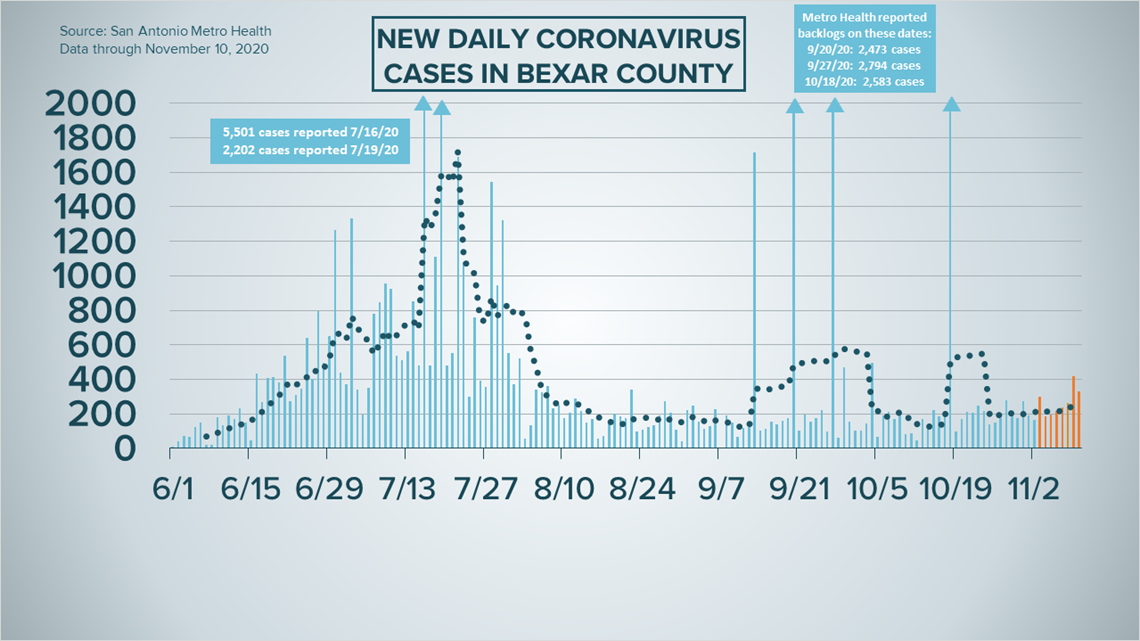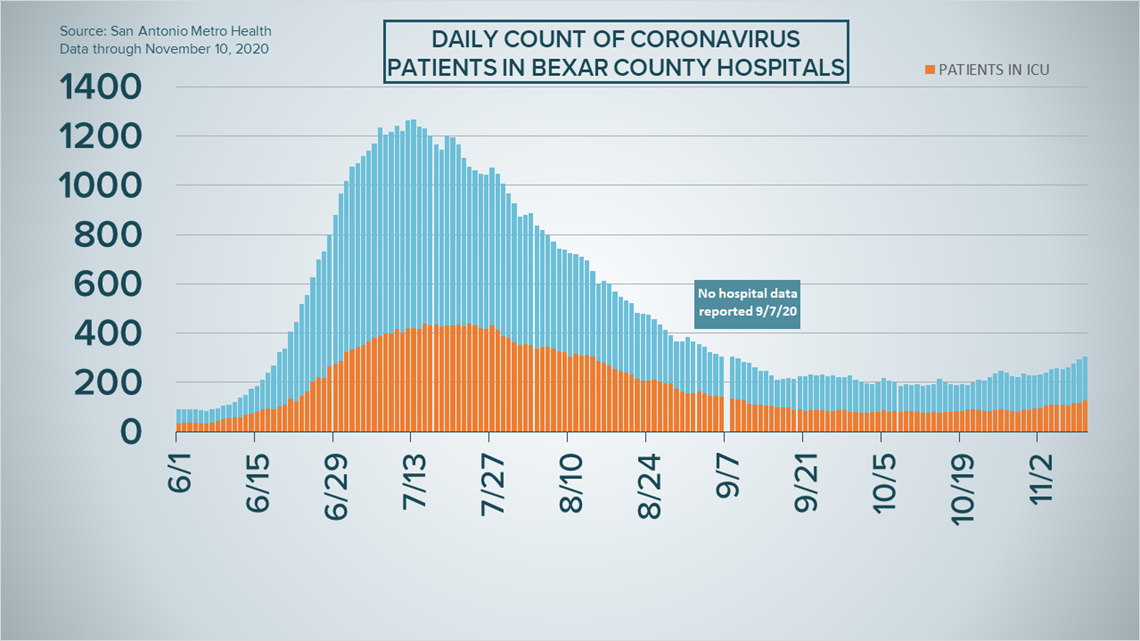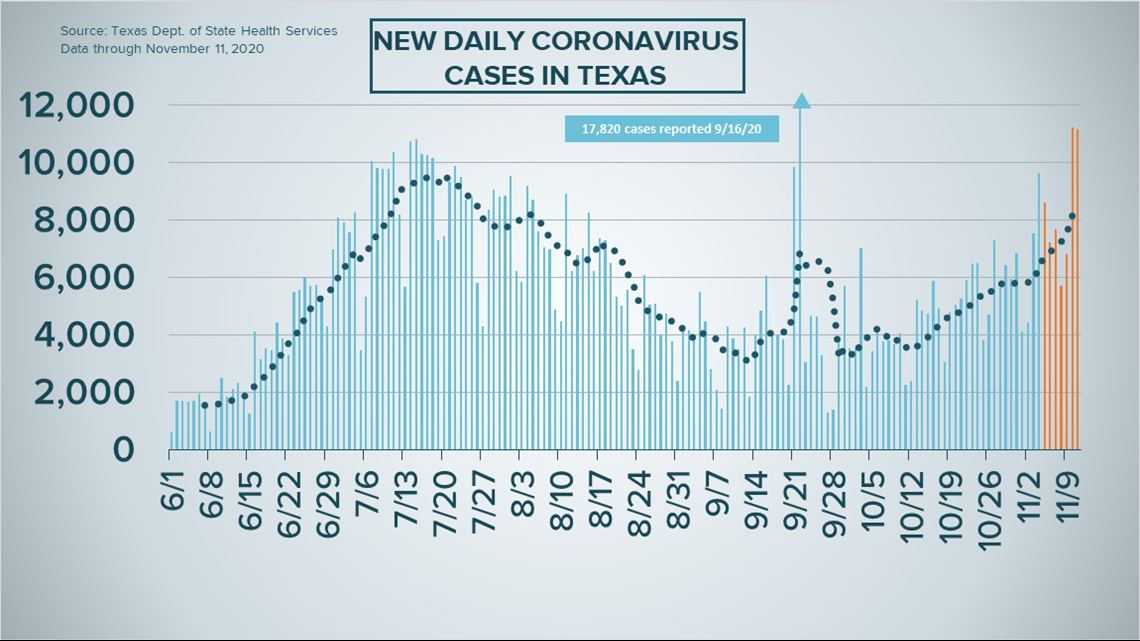SAN ANTONIO — We're tracking the latest numbers from the coronavirus pandemic in San Antonio and across Texas. Here are the latest numbers reported by Bexar and surrounding counties:
- Bexar County: No data was reported Wednesday. 332 new cases were reported Tuesday, bringing the total number of cases for the county to 68,376. No new deaths were reported; the death toll remains at 1,285.
- Comal County: The county reported 11 new COVID-19 cases Thursday. One new virus-related death was reported. There have been a total of 4,008 reported cases of COVID-19 in the county – including 2,961 lab-confirmed cases – while 124 county residents have died. County officials say there are 223 active coronavirus cases, and 3,661 residents are considered recovered.
- Hays County: No data was reported Wednesday. Officials in Hays County on Tuesday reported 73 new cases in the county and no additional virus-related deaths. As of Tuesday, there are a total of 6,486 lab-confirmed cases in the county (412 of which are active), while the death toll remained at 91. 5,983 residents have recovered from the virus. (No data was reported Wednesday)
How Bexar County is trending
We've tracked how many coronavirus cases have been confirmed in Bexar County from the time officials began reporting cases in March 2020. The graphic below shows the number of cases since June and charts those daily case numbers along a 7-day moving average to provide a more accurate picture of the overall coronavirus case curve in our area and the direction we're trending amid the pandemic.
Bexar County did not release new COVID-19 data Wednesday, in observance of Veterans Day. As of Tuesday evening, at least 68,376 county residents have been diagnosed with the coronavirus during the pandemic, and 1,285 residents have died due to coronavirus complications.
306 COVID-19 patients were receiving treatment at local facilities, as of Tuesday evening. 61 of those patients are from El Paso, a region that has been particularly devastated by the virus in recent weeks.
There are currently 57 patients on ventilators and 128 in intensive care.
The county's seven-day moving average rose to 239, as of Tuesday evening. The positivity rate in Bexar County sits at 8.7%.
Tuesday evening, San Antonio Mayor Ron Nirenberg announced he was self-quarantining as a precautionary measure after learning he was potentially "exposed" to the coronavirus. The mayor tested negative for COVID-19.
At Tuesday's briefing, Assistant City Manager Colleen Bridger emphasized that anyone who may have interacted with Nirenberg in the past few days "is not at an elevated risk."
Here are the most up-to-date local coronavirus trend graphs:




Coronavirus in Texas
The number of Texans who have tested positive for the coronavirus since the pandemic began grew by 11,150 on Tuesday, according to the Texas Department of State Health Services.
10,097 of those are new diagnoses over the last 24 hours; another 1,053 cases stem from a number of backlogs in several counties. More details can be found at the top of this page.
As of Wednesday, at least 1.021 million Texans have contracted COVID-19. This includes 985,380 cases confirmed positive by PCR molecular testing as well as 36,301 antigen-positive cases as reported by DSHS.


State health authorities reported 141 additional virus-related deaths on Wednesday. At least 19,004 Texans have passed away from COVID-19 complications.
Meanwhile, the overall number of Texans hospitalized for COVID-19 on Wednesday rose drastically in the past 24 hours. A total of 6,779 Texas residents are currently receiving COVID-19 treatment in state hospitals, up 609 since Tuesday.
Since Oct. 1, the number of Texas hospitalizations has spiked by 112%.
The state estimates that 831,800 Texans have recovered, while 137,054 Texans remain ill with COVID-19.
Meanwhile, the latest update from the Texas Education Agency showed that there have been 31,987 cumulative cases among staff and students across the state through Nov. 1. More information can be found here.
The TEA releases new data on school cases every Thursday.
Latest Coronavirus Headlines
- Mayor Nirenberg tests negative for COVID-19 after potential exposure, says he will remain quarantined
- Olympic leaders raise hopes for Tokyo Games with fans in attendance
- TEA: Schools can stop remote learning for struggling students
- CDC study shows working in the office doubles coronavirus risk, compared to working at home
- Funeral homes and hospitals in parts of Texas brace for new wave of coronavirus infections and deaths
- Texas becomes 1st state to surpass 1 million COVID-19 cases
- CDC's new COVID-19 guidance says masks protect wearers and those around them
- US sets record for COVID-19 hospitalizations, but signs show we're better prepared now
Coronavirus symptoms
The symptoms of coronavirus can be similar to the flu or a bad cold. Symptoms include fever or chills, cough, shortness of breath or difficulty breathing, fatigue, muscle or body aches, headache, new loss of taste or smell sore throat, congestion or runny nose, nausea or vomiting and diarrhea, according to the Centers for Disease Control.
Most healthy people will have mild symptoms. A study of more than 72,000 patients by the Centers for Disease Control in China showed 80 percent of the cases there were mild.
But infections can cause pneumonia, severe acute respiratory syndrome, kidney failure, and even death, according to the World Health Organization. Older people with underlying health conditions are most at risk.
But infections can cause pneumonia, severe acute respiratory syndrome, kidney failure, and even death, according to the World Health Organization. Older people with underlying health conditions are most at risk.
Experts determined there was consistent evidence these conditions increase a person's risk, regardless of age:
- Chronic kidney disease
- COPD (chronic obstructive pulmonary disease)
- Obesity (BMI of 30 or higher)
- Immunocompromised state (weakened immune system) from solid organ transplant
- Serious heart conditions, such as heart failure, coronary artery disease, or cardiomyopathies
- Sickle cell disease
- Type 2 diabetes
The CDC believes symptoms may appear anywhere from two to 14 days after being exposed.
Human coronaviruses are usually spread...
- Between people who are in close contact with one another (within about 6 feet).
- Through respiratory droplets produced when an infected person coughs, sneezes or talks. These droplets can land in the mouths or noses of people who are nearby or possibly be inhaled into the lungs.
- Some recent studies have suggested that COVID-19 may be spread by people who are not showing symptoms.
Help stop the spread of coronavirus
- Stay home when you are sick.
- Eat and sleep separately from your family members
- Use different utensils and dishes
- Cover your cough or sneeze with your arm, not your hand.
- If you use a tissue, throw it in the trash.

